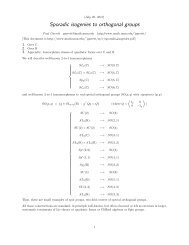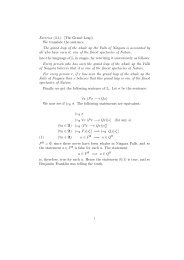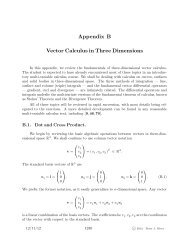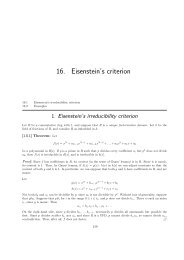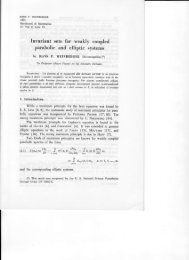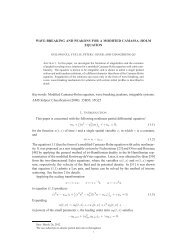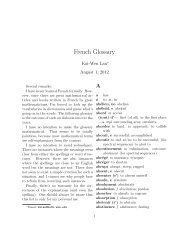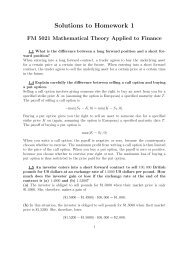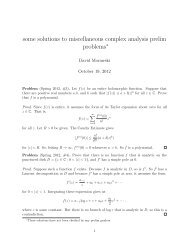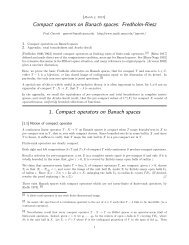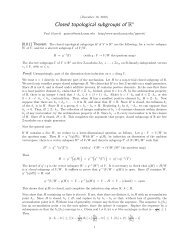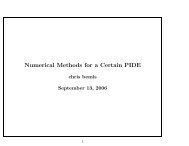Exponential Dichotomies for Linear Non-autonomous - School of ...
Exponential Dichotomies for Linear Non-autonomous - School of ...
Exponential Dichotomies for Linear Non-autonomous - School of ...
You also want an ePaper? Increase the reach of your titles
YUMPU automatically turns print PDFs into web optimized ePapers that Google loves.
<strong>Exponential</strong> <strong>Dichotomies</strong> <strong>for</strong><br />
<strong>Linear</strong> <strong>Non</strong>-<strong>autonomous</strong><br />
Functional Differential Equations <strong>of</strong> Mixed Type<br />
JÖRG HÄRTERICH, BJÖRN SANDSTEDE, AND ARND SCHEEL<br />
ABSTRACT. Functional differential equations with <strong>for</strong>ward and<br />
backward delays arise naturally, <strong>for</strong> instance, in the study <strong>of</strong> travelling<br />
waves in lattice equations and as semi-discretizations <strong>of</strong><br />
partial differential equations (PDEs) on unbounded domains.<br />
<strong>Linear</strong> functional differential equations <strong>of</strong> mixed type are typically<br />
ill-posed, i.e., there exists, in general, no solution to a given<br />
initial condition. We prove that Fredholm properties <strong>of</strong> these<br />
equations imply the existence <strong>of</strong> exponential dichotomies. <strong>Exponential</strong><br />
dichotomies can be used in discretized PDEs and in lattice<br />
differential equations to construct multi-pulses, to per<strong>for</strong>m<br />
Evans-function type calculations, and to justify numerical computations<br />
using artificial boundary conditions.<br />
1. INTRODUCTION<br />
We are interested in linear non-<strong>autonomous</strong> functional differential equations<br />
m∑<br />
(1.1) v ′ (ξ) = A j (ξ)v(ξ + j),<br />
j=−m<br />
ξ ∈ R<br />
<strong>of</strong> mixed type, where v ∈ C n ,andA j (ξ) are continuous functions with values<br />
in C n×n <strong>for</strong> |j| ≤m. Be<strong>for</strong>e we motivate our interest in this equation and list<br />
a number <strong>of</strong> applications that we have in mind, we discuss a few properties <strong>of</strong><br />
(1.1). The most important feature <strong>of</strong> (1.1), at least <strong>for</strong> the purpose <strong>of</strong> this paper, is<br />
that the associated initial-value problem is ill-posed. To make this statement more<br />
precise, we should first explain in what sense we want to solve (1.1): We say that<br />
a function v(ξ) satisfies (1.1) on an interval J = [a, b], where a =∞and b =∞<br />
1081<br />
Indiana University Mathematics Journal c○, Vol. 51, No. 5 (2002)
1082 JÖRG HÄRTERICH. BJÖRN SANDSTEDE, AND ARND SCHEEL<br />
are allowed, if v ∈ L 2 loc([a−m, b+m], C n ) ∩ H 1 loc([a, b], C n ), and (1.1) is met<br />
in L 2 loc([a, b], C n ). The initial-value problem associated with (1.1) is given by<br />
(1.2) v ′ (ξ) =<br />
m∑<br />
j=−m<br />
A j (ξ)v(ξ + j), v| [−m,m] = φ,<br />
where φ is a given function defined on [−m, m]. Un<strong>for</strong>tunately, <strong>for</strong> a given<br />
function φ, there is in general no solution, in the above sense, to (1.2) on any<br />
nontrivial interval that contains ξ = 0. A simple counterexample (see [15]) is<br />
provided by the equation<br />
(1.3) v ′ (ξ) = v(ξ −1) + v(ξ +1), v| [−m,m] = 1<br />
with v ∈ C. The only function that could possibly be a solution <strong>of</strong> this initialvalue<br />
problem is given by v(ξ) = (−1) k <strong>for</strong> ξ ∈ (2k−1, 2k+1] with k ∈ N;<br />
this function, however, is not even continuous. Seeking solutions <strong>of</strong> the <strong>for</strong>m<br />
v(ξ) = e λξ , we see that the characteristic eigenvalue equation associated with<br />
(1.3) is<br />
λ = e −λ + e λ .<br />
This equation has solutions λ ∈ C with Re λ arbitrarily large and also admits<br />
solutions <strong>for</strong> which − Re λ is arbitrarily large. There<strong>for</strong>e, the linear equation (1.3)<br />
does not generate a semiflow on any space that contains all its eigenfunctions. This<br />
explains why the initial-value problem (1.2) associated with (1.1) is ill-posed. In<br />
fact, functional differential equations <strong>of</strong> mixed type behave quite similar to elliptic<br />
PDEs when considered as initial-value problems. Note also that solving (1.1)<br />
<strong>for</strong>ward or backward in the time variable ξ is equally difficult.<br />
Since we cannot solve (1.2) <strong>for</strong> all φ, we should there<strong>for</strong>e find those functions<br />
φ <strong>for</strong> which a solution to (1.2) exists on either R + or R − . In particular, we would<br />
expect to be able to solve the linear <strong>autonomous</strong> equation (1.3) <strong>for</strong> ξ >0<strong>for</strong><br />
any initial condition φ that is a superposition <strong>of</strong> eigenfunctions associated with<br />
stable eigenvalues (i.e., eigenvalues with negative real part). In fact, the resulting<br />
solution should decay to zero exponentially as ξ →∞. Analogously, we should<br />
be able to solve (1.3) on R − <strong>for</strong> any initial condition φ that is a superposition<br />
<strong>of</strong> eigenfunctions associated with unstable eigenvalues (i.e., eigenvalues <strong>of</strong> positive<br />
real part), and the solution should decay exponentially as ξ →−∞. Using<br />
results from [1] about the characteristic equation, Rustichini [15] proved these<br />
assertions <strong>for</strong> <strong>autonomous</strong> equations. His result leads naturally to the question<br />
how large the closure <strong>of</strong> all eigenfunctions associated with either stable or unstable<br />
eigenvalues is. Indeed, the sum <strong>of</strong> the resulting closed spaces gives the function<br />
space on which we can construct solutions to (1.1) on either R + or R − . The difficulty<br />
in determining whether this sum is the entire underlying function space,<br />
i.e., whether the set <strong>of</strong> eigenfunctions is complete, lies in the problem <strong>of</strong> excluding<br />
solutions that decay super-exponentially, so-called small solutions. Verduyn Lunel
<strong>Linear</strong> <strong>Non</strong>-<strong>autonomous</strong> Functional Differential Equations 1083<br />
[19] gave conditions that guarantee that the set <strong>of</strong> eigenfunctions associated with<br />
an <strong>autonomous</strong> functional differential equation is complete.<br />
In this paper, we address the above issues <strong>for</strong> non-<strong>autonomous</strong> functional<br />
differential equations <strong>of</strong> mixed type. The obvious difficulty is that the spaces on<br />
which we can solve (1.1) <strong>for</strong>ward or backward in time will depend on ξ. Itisnot<br />
apriori clear which spaces will replace the unstable and stable eigenspaces that were<br />
so useful <strong>for</strong> <strong>autonomous</strong> equations. It turns out that the correct notion in the<br />
non-<strong>autonomous</strong> setup are exponential dichotomies. An exponential dichotomy<br />
<strong>for</strong>malizes the idea <strong>of</strong> solving (1.1) either <strong>for</strong>ward or backward in ξ <strong>for</strong> initial<br />
conditions in certain complementary subspaces even though these subspaces will<br />
depend on ξ.<br />
To <strong>for</strong>mulate the definition <strong>of</strong> exponential dichotomies in the present context,<br />
it is convenient to introduce the following notation, which we shall use frequently.<br />
For a given function v : [−m, ∞) → C n ,wedefinev ξ :[−m, m] → C n via<br />
v ξ (η) := v(ξ + η) <strong>for</strong> η ∈ [−m, m].<br />
Definition 1.1 ([14]). Let J = [a, b] be R + , R − or R. Equation (1.1)<br />
is said to have an exponential dichotomy on the interval J if there exist positive<br />
constants K and κ, and a strongly continuous family <strong>of</strong> projections P(ξ) :<br />
L 2 ([−m, m], C n ) → L 2 ([−m, m], C n ) such that the following is true <strong>for</strong> any<br />
φ ∈ L 2 ([−m, m], C n ) and ζ ∈ J.<br />
(i) There exists a unique solution v on [ζ, b] <strong>of</strong> (1.1) such that v ζ = P(ζ)φ.<br />
In addition, v ξ ∈ R(P(ξ)) and<br />
‖v ξ ‖ L 2 ([−m,m],C n ) ≤ Ke −κ|ξ−ζ| ‖φ‖ L 2 ([−m,m],C n )<br />
<strong>for</strong> all ξ ≥ ζ with ξ, ζ ∈ J.<br />
(ii) There exists a unique solution v on [a, ζ] <strong>of</strong> (1.1) such that v ζ =<br />
(id −P(ζ))φ. In addition, v ξ ∈ N(P(ξ)) and<br />
‖v ξ ‖ L 2 ([−m,m],C n ) ≤ Ke −κ|ξ−ζ| ‖φ‖ L 2 ([−m,m],C n )<br />
<strong>for</strong> all ξ ≤ ζ with ξ, ζ ∈ J.<br />
<strong>Exponential</strong> dichotomies have been shown to exist in ordinary differential<br />
equations [4], parabolic PDEs [7] and delay equations [6], where the unstable<br />
subspace N(P(ξ)) is always finite-dimensional, and the initial-value problem is<br />
well-posed. In [14], the existence <strong>of</strong> exponential dichotomies has been established<br />
<strong>for</strong> elliptic PDEs on unbounded domains. Here, both R(P(ξ)) and N(P(ξ)) are<br />
infinite-dimensional, and the initial-value problem is ill-posed.<br />
Associated with (1.1) is the operator<br />
L : H 1 (R, C n ) → L 2 (R, C n ),<br />
(Lv)(ξ) = dv<br />
dξ (ξ) −<br />
m ∑<br />
j=−m<br />
A j (ξ)v(ξ + j)
1084 JÖRG HÄRTERICH. BJÖRN SANDSTEDE, AND ARND SCHEEL<br />
and its <strong>for</strong>mal adjoint L ∗ , defined on the same spaces, given by<br />
(L ∗ w)(ξ) =− dw<br />
dξ (ξ) −<br />
m ∑<br />
j=−m<br />
A ∗ j<br />
(ξ − j)w(ξ − j).<br />
We need the following weak uniqueness assumption.<br />
Hypothesis 1.1. If v is in the null space <strong>of</strong> L or the adjoint operator L ∗ such<br />
that v| [ξ0 −m,ξ 0 +m] = 0<strong>for</strong>someξ 0 , then v vanishes identically.<br />
Our main result is the following theorem.<br />
Theorem 1.1. If L is a Fredholm operator and if Hypothesis 1.1 is met, then<br />
(1.1) has exponential dichotomies on R + and on R − .<br />
A weaker but perhaps more explicit version <strong>of</strong> the above theorem is the following<br />
statement.<br />
Theorem 1.2. If (1.1) is asymptotically hyperbolic (see Definition 2.1 below)<br />
and if neither det A m (ξ) nor det A −m (ξ) vanish on any open interval, then (1.1)<br />
has exponential dichotomies on R + and on R − .<br />
Analogous results have been shown, independently and simultaneously, in<br />
[12].<br />
The existence <strong>of</strong> exponential dichotomies on R + and R − hasanumber<strong>of</strong><br />
consequences: <strong>for</strong> instance, the null space and the orthogonal complement <strong>of</strong> the<br />
range <strong>of</strong> L are isomorphic to the spaces R(P + (0)) ∩ N(P − (0)) and (R(P + (0)) +<br />
N(P − (0))) ⊥ , respectively. In addition, it is possible to characterize the Fredholm<br />
index <strong>of</strong> L by the difference <strong>of</strong> relative Morse indices. We refer to [18] <strong>for</strong> details.<br />
Lastly, we motivate why functional differential equations are interesting and<br />
outline some applications <strong>of</strong> exponential dichotomies that we intend to pursue in<br />
future work. <strong>Linear</strong> non-<strong>autonomous</strong> functional differential equations <strong>of</strong> mixed<br />
type arise in many different problems. We may, <strong>for</strong> instance, be interested in<br />
travelling waves <strong>of</strong> lattice differential equations<br />
∂ t u k =<br />
m∑<br />
j=−m<br />
f j (u k+j ), k ∈ Z,<br />
where u j = u j (t) <strong>for</strong> j ∈ Z. A travelling-wave solution is a function ϕ(ξ) such<br />
that, <strong>for</strong> some wave speed c ∈ R, wehaveu k (t) = ϕ(k + ct) <strong>for</strong> t ∈ R and<br />
k ∈ Z. Upon substituting this expression <strong>for</strong> u k into the above lattice equation,<br />
we obtain<br />
m∑<br />
cϕ ′ (ξ) = f j (ϕ(ξ + j)), ξ ∈ R,<br />
j=−m
<strong>Linear</strong> <strong>Non</strong>-<strong>autonomous</strong> Functional Differential Equations 1085<br />
where we set ξ = k + ct. The linearization about the wave ϕ(ξ) is then given by<br />
cv ′ (ξ) =<br />
m∑<br />
j=−m<br />
Df j (ϕ(ξ + j))v(ξ + j) =:<br />
m∑<br />
j=−m<br />
A j (ξ)v(ξ + j)<br />
which is <strong>of</strong> the <strong>for</strong>m (1.1) provided the wave speed c does not vanish. Note that,<br />
if c = 0, then the above equation is a difference equation. A second example are<br />
semi-discretizations <strong>of</strong> parabolic PDEs such as<br />
∂ t u = D∂ 2 x u + f(u),<br />
u ∈Rn ,x∈R<br />
that admit travelling-wave solutions which connect two, possibly different, homogeneous<br />
equilibria. Since such equations are <strong>of</strong>ten too complicated to allow <strong>for</strong> a<br />
complete analysis, numerical methods have to be employed to compute travelling<br />
waves and to continue them in parameter space. An important question is then<br />
to which extent the numerical scheme is able to reproduce travelling waves <strong>of</strong> the<br />
original PDE and whether the stability properties <strong>of</strong> the wave are retained upon<br />
discretizing. We shall investigate these issues in a simplified setting: instead <strong>of</strong><br />
considering a fully discrete numerical scheme, we may study semi-discretizations,<br />
i.e., equations where only the spatial derivatives are replaced by finite difference<br />
approximations. The resulting lattice equations are <strong>of</strong> the <strong>for</strong>m<br />
∂ t u(x, t) =<br />
m∑<br />
j=−m<br />
α j u(x+jh, t) + f (u(x, t)),<br />
where the coefficients α j may depend on the mesh size h. Let ξ := (x + ct)/h,<br />
then a travelling wave <strong>of</strong> the <strong>for</strong>m u(x, t) = ϕ ( (x +ct)/h ) satisfies the nonlinear<br />
functional differential equation<br />
c<br />
h ϕ′ (ξ) =<br />
m∑<br />
j=−m<br />
α j ϕ(ξ + j) + f (ϕ(ξ)).<br />
We assume that we have found a solution ϕ(ξ) <strong>of</strong> this equation and consider the<br />
linearization<br />
c<br />
h v′ (ξ) =<br />
m∑<br />
j=−m<br />
α j v(ξ + j) + Df (ϕ(ξ))v(ξ)<br />
about the wave. If the wave speed c ≠ 0 is not zero, we obtain a functional differential<br />
equation <strong>of</strong> mixed type as in our first example. <strong>Exponential</strong> dichotomies<br />
provide a useful tool to investigate such equations. In a nutshell (see [18] <strong>for</strong><br />
a more comprehensive discussion), exponential dichotomies allow <strong>for</strong> a much
1086 JÖRG HÄRTERICH. BJÖRN SANDSTEDE, AND ARND SCHEEL<br />
more refined perturbation analysis compared with, <strong>for</strong> instance, Fredholm properties.<br />
One example where dichotomies are useful is in providing correct choices<br />
<strong>of</strong> boundary conditions so that (1.1) truncated to an interval (−L, L) with L ≫ 1<br />
is well-posed (see [10] and the references therein). <strong>Dichotomies</strong> are also useful in<br />
the construction <strong>of</strong> Evans functions that can be used to investigate linear stability<br />
<strong>of</strong> travelling waves (see, <strong>for</strong> instance, [2, 18, 17] and references therein). Lastly,<br />
exponential dichotomies can be used to construct new patterns, such as periodic<br />
or multi-hump waves, from a given travelling wave by using, <strong>for</strong> example, Lin’s<br />
method [9, 16]. Some <strong>of</strong> the above issues will be investigated in more detail in a<br />
<strong>for</strong>thcoming article.<br />
This paper is organized as follows. In Section 2, we <strong>for</strong>mulate (1.1) as an<br />
evolution problem and introduce several operators relevant to that <strong>for</strong>mulation.<br />
In Section 3, we then show the existence <strong>of</strong> exponential dichotomies <strong>for</strong> the corresponding<br />
<strong>autonomous</strong> equation. The analysis is similar to the one given in<br />
[15] and uses additional results from [19]. Lastly, in Section 4, we consider the<br />
non-<strong>autonomous</strong> equation <strong>for</strong> which we prove the existence <strong>of</strong> exponential dichotomies<br />
following the strategy in [18].<br />
Acknowledgments. J. Härterich was supported by the Deutsche Forschungsgemeinschaft<br />
under grant Ha 3008/1-1. B. Sandstede was partially supported by<br />
the National Science Foundation under grant DMS-9971703 and by an Alfred<br />
P. Sloan Research Fellowship.<br />
2. THE OPERATORS L AND T<br />
In this section we describe two linear operators that can be associated with the<br />
linear functional differential equation<br />
(2.1) v ′ (ξ) =<br />
m∑<br />
j=−m<br />
A j (ξ)v(ξ + j)<br />
and show how they are related.<br />
2.1. The operators L and L ∗ . We define the closed and densely defined<br />
linear operator<br />
L: D(L) = H 1 (R, C n ) → L 2 (R, C n ),<br />
(Lv)(ξ) = dv<br />
m dξ (ξ) −<br />
∑<br />
A j (ξ)v(ξ + j)<br />
j=−m<br />
associated with equation (2.1). The adjoint operator L ∗ <strong>of</strong> L is given by<br />
(L ∗ w)(ξ) =− dw<br />
dξ (ξ) −<br />
m ∑<br />
j=−m<br />
A ∗ j<br />
(ξ − j)w(ξ − j).
It is easily checked that<br />
<strong>Linear</strong> <strong>Non</strong>-<strong>autonomous</strong> Functional Differential Equations 1087<br />
∫ ∞<br />
∫ ∞<br />
(Lv)(ξ) · w(ξ)dξ = v(ξ) · (L ∗ w)(ξ) dξ<br />
−∞<br />
−∞<br />
<strong>for</strong> all v,w ∈ H 1 (R,C n ), where we denote the scalar product in C n by a · b =<br />
∑ n<br />
k=1 a k b k <strong>for</strong> a, b ∈ C n . The operator L has particularly nice properties if the<br />
coefficients A j satisfy a certain hyperbolicity condition.<br />
Definition 2.1. The linear functional differential equation (2.1) is called<br />
asymptotically constant if the limits A ± j<br />
:= lim ξ→±∞ A j (ξ) exist <strong>for</strong> all j. The<br />
equation is called asymptotically hyperbolic if it is asymptotically constant and if<br />
the characteristic equations<br />
det ∆ ± (µ) := det (<br />
m ∑<br />
j=−m<br />
)<br />
A ± j eµj − µ id = 0<br />
associated with the limiting equations at ξ = ±∞have no solutions µ on the<br />
imaginary axis. If the coefficients do not depend on ξ, then we call (2.1) hyperbolic<br />
if det ∆(µ) has no purely imaginary zeros µ.<br />
The following result is due to Mallet-Paret [11].<br />
Proposition 2.1 ([11]). If L is asymptotically hyperbolic, then L is a Fredholm<br />
operator.<br />
2.2. The operator T . Adifferent way <strong>of</strong> viewing (2.1) is to write it in the<br />
<strong>for</strong>m<br />
dV<br />
(2.2)<br />
(ξ) =A(ξ)V (ξ)<br />
dξ<br />
where, <strong>for</strong> each fixed ξ ∈ R, wedefine<br />
A(ξ) : D(A(ξ)) = Y 1 → Y,<br />
⎛<br />
( φ ↦→<br />
a)<br />
⎜<br />
⎝A 0 (ξ)a +<br />
with<br />
dφ<br />
∑<br />
dη<br />
1≤|j|≤m<br />
⎞<br />
⎟<br />
A j (ξ)φ(j) ⎠<br />
(2.3)<br />
Y := L 2 ([−m, m], C n ) × C n<br />
Y 1 :={(φ, a) ∈ H 1 ([−m, m], C n ) × C n ; φ(0) = a}.<br />
The space Y 1 is well defined since H 1 ([−m, m], C n ) is embedded in<br />
C 0 ([−m, m], C n ). Note also that Y 1 is dense in Y since the set <strong>of</strong> C 1 -functions
1088 JÖRG HÄRTERICH. BJÖRN SANDSTEDE, AND ARND SCHEEL<br />
φ with φ(0) = a is dense in the set <strong>of</strong> step functions in the L 2 -norm. The operator<br />
A(ξ) has domain Y 1 and is closed <strong>for</strong> any fixed ξ. In the case <strong>of</strong> constant<br />
coefficients, we write A 0 instead <strong>of</strong> A(ξ).<br />
Be<strong>for</strong>e we define the operator T , we state the following lemma that we use<br />
below to define the domain <strong>of</strong> T .<br />
Lemma 2.1. Using the notation I = [−m, m] and (ξ, η) ∈ R×I,wehavethat<br />
L 2 (R,L 2 (I, C n )) = L 2 (R×I,C n ). Furthermore, there is a constant C with the following<br />
property. If φ ∈ L 2 (R × I,C n ) such that the weak derivative<br />
(∂ ξ − ∂ η )φ ∈ L 2 (R × I,C n ) exists, then φ(·,k) ∈ L 2 (R,C n )<strong>for</strong> every fixed k ∈ I<br />
and φ(0, ·) ∈ L 2 (I, C n ); in addition, we have<br />
‖φ(0, ·)‖ L 2 (I,C n )+‖φ(·,k)‖ L 2 (R,C n ) ≤C(‖φ‖ L 2 (R×I,C n )+‖(∂ ξ −∂ η )φ‖ L 2 (R×I,C n )).<br />
Pro<strong>of</strong>. The identity L 2 (R,L 2 (I, C n )) = L 2 (R × I,C n ) is a consequence <strong>of</strong><br />
Fubini’s theorem. Upon introducing the coordinates ( ˜ξ, ˜η) = (ξ+η, η) ∈ R × I,<br />
we see that φ(ξ, η) ∈ L 2 (R × I,C n ) with (∂ ξ − ∂ η )φ(ξ, η) ∈ L 2 (R × I,C n )<br />
if, and only if, ˜φ( ˜ξ, ˜η) := φ( ˜ξ− ˜η, ˜η) ∈ L 2 (R,H 1 (I, C n )). In particular, ˜φ ∈<br />
L 2 (R,C 0 (I, C n )), and we conclude that ˜φ(·,k)∈L 2 (R,C n )<strong>for</strong> every fixed k ∈ I.<br />
Hence, φ(ξ, k) = ˜φ(ξ+k, k) ∈ L 2 (R, C n ) <strong>for</strong> fixed k. Lastly, <strong>for</strong> any such φ,we<br />
also have that φ(0,η)= ˜φ(η, η) exists <strong>for</strong> almost every η ∈ I. It is straight<strong>for</strong>ward<br />
to see that the L 2 -norm <strong>of</strong> ˜φ(η, η) can be bounded by the L 2 (R × I)-norms <strong>of</strong> φ<br />
and (∂ ξ − ∂ η )φ upon using the coordinates ( ˜ξ, ˜η).<br />
Associated with (2.2) is the operator<br />
T : L 2 (R,Y) → L 2 (R,Y), V ↦→ dV (·)−A(·)V (·)<br />
dξ<br />
⎛<br />
(φ, a) ↦ → ⎝ dφ<br />
dξ − dφ<br />
dη , da<br />
dξ (ξ) − A 0(ξ)a(ξ) −<br />
∑<br />
1≤|j|≤m<br />
which is considered as an unbounded operator on L 2 (R,Y)with domain<br />
❐<br />
⎞<br />
A j (ξ)[φ(ξ)](j) ⎠<br />
(2.4) D(T ) ={(φ, a) ∈ L 2 (R,Y); (∂ ξ − ∂ η )φ ∈ L 2 (R × I,C n ),<br />
a ∈ H 1 (R, C n ), [φ(ξ)](0) = a(ξ) ∀ξ}<br />
where we use the notation I = [−m, m]. Note that D(T ) is well-defined owing<br />
to Lemma 2.1. Using again Lemma 2.1, it is not difficult to prove that T is closed<br />
and densely defined.<br />
Note that we have L 2 (R,Y 1 ) ∩ H 1 (R,Y) ⊂ D(T). It is tempting to take<br />
L 2 (R,Y 1 ) ∩ H 1 (R,Y) as the domain <strong>of</strong> T . The operator T is, however, not<br />
closed if considered with this domain.
<strong>Linear</strong> <strong>Non</strong>-<strong>autonomous</strong> Functional Differential Equations 1089<br />
The following lemma shows how the null spaces <strong>of</strong> the operators L and T are<br />
related.<br />
Lemma 2.2. If a function v ∈ H 1 (R, C n ) satisfies Lv = 0, thenV(ξ) :=<br />
(v| [ξ−m,ξ+m] , v(ξ)) satisfies V ∈ D(T ) and T V = 0. Conversely, if V = (φ, a) ∈<br />
D(T ) satisfies T V = 0, then a∈H 1 (R,C n )satisfies La = 0. In particular,<br />
N(L) ≅ N(T ).<br />
Pro<strong>of</strong>. If v ∈ H 1 (R, C n ) is a solution to Lv = 0, then v is in fact <strong>of</strong> class<br />
C ∞ . To see this, it suffices to show that v ∈ C k ([−l, l], C n ) <strong>for</strong> arbitrarily large<br />
numbers k and l. By the Sobolev Embedding Theorem, v is in C 0 on the interval<br />
[−l−mk, l+mk]. Since vsatisfies (2.1), it is C 1 on the smaller interval<br />
[−l−(k − 1)m, l+(k−1)m]. Inductively one can then show that v is indeed <strong>of</strong><br />
class C k on [−l, l]. As a consequence, V(ξ) := (v ξ , v(ξ)) is a classical solution<br />
<strong>of</strong> (2.2). It remains to check that V is in the domain <strong>of</strong> T .Sincev∈H 1 (R,C n ),<br />
we know that<br />
∫ ∫ m<br />
‖V ‖ L 2 (R,Y 1 ) = (|v ξ (η)| 2 +|∂ η v ξ (η)| 2 ) dη dξ +‖v‖ H 1 (R,C n )<br />
R −m<br />
∫ m<br />
= (|v(ξ + η)|<br />
R∫ 2 +|v ′ (ξ + η)| 2 ) dη dξ +‖v‖ H 1 (R,C n )<br />
−m<br />
=(2m+1)‖v‖ H 1 (R,C n ),<br />
and we conclude that V is in L 2 (R,Y 1 ). Note that v ∈ H 1 (R, C n ) is in the domain<br />
<strong>of</strong> the derivative which is the generator <strong>of</strong> the shift semigroup on L 2 (R, C n ).<br />
There<strong>for</strong>e,<br />
d<br />
d<br />
v(ξ +·)= v(ξ +·).<br />
dξ dη<br />
Hence V is in H 1 (R,Y)and there<strong>for</strong>e indeed in L 2 (R,Y 1 )×H 1 (R,Y)⊂D(T).<br />
To show the other direction, assume that V = (φ, a) ∈ D(T ) satisfies T V =<br />
0. It follows from the definition <strong>of</strong> D(T ) that v(ξ) = a(ξ) = [φ(ξ)](0) is<br />
well-defined and v ∈ H 1 (R, C n ). It remains to show that a| [ξ−m,ξ+m] = φ(ξ),<br />
i.e., [φ(ξ + η)](0) = [φ(ξ)](η). As in Lemma 2.1, we use the coordinates<br />
( ˜ξ, ˜η) = (ξ+η, η) ∈ R×I and set ˜φ( ˜ξ, ˜η) := [φ( ˜ξ − ˜η)]( ˜η). From d dξ φ= d<br />
dη φ,<br />
we conclude that ˜φ( ˜ξ, ˜η) = ˜φ( ˜ξ,0) <strong>for</strong> almost every ˜ξ, and there<strong>for</strong>e <strong>for</strong> every ˜ξ<br />
as [φ(ξ)](0) is continuous. Hence, [φ(ξ − η)](η) = [φ(ξ)](0) <strong>for</strong> every ξ and<br />
η, and we conclude that [φ(ξ + η)](0) = [φ(ξ)](η).<br />
2.3. The adjoint operator T ∗ . We denote by 〈·, ·〉 the inner product<br />
〈( ( )〉 ∫ φ ψ ∞ ∫ m ∫ ∞<br />
, := φ(ξ, η) · ψ(ξ, η) dη dξ + a(ξ) · b(ξ) dξ<br />
a)<br />
b −∞ −m<br />
−∞<br />
❐<br />
on L 2 (R,Y).
1090 JÖRG HÄRTERICH. BJÖRN SANDSTEDE, AND ARND SCHEEL<br />
Remark 2.1. Let j be an integer with −m ≤ j < m. If ψ ∈<br />
L 2 (R×[j, j+1], C n ) with weak derivative (∂ ξ − ∂ η )ψ ∈ L 2 (R × (j, j+1), C n ),<br />
then ψ(·,j)and ψ(·, j+1)are in L 2 (R, C n ) by Lemma 2.1. We use the notation<br />
ψ(·,j+) := ψ(·,j) and ψ(·, (j+1)−):=ψ(·, j+1). For convenience, we also<br />
define ψ(·,m+)=ψ(·, −m−) = 0.<br />
Lemma 2.3. The adjoint operator T ∗ is given by<br />
T ∗ : L 2 (R,Y) →L 2 (R,Y),<br />
(<br />
(ψ, b) ↦ → − dψ<br />
dξ + dψ<br />
)<br />
dη , −db dξ − A∗ 0 (ξ)b + ψ(·, 0−) − ψ(·, 0+)<br />
with<br />
D(T ∗ ) ={(ψ, b) ∈ L 2 (R,Y); (∂ ξ − ∂ η )ψ ∈ L 2 (R × (j, j+1), C n )<br />
∀j with − m ≤ j
<strong>Linear</strong> <strong>Non</strong>-<strong>autonomous</strong> Functional Differential Equations 1091<br />
Upon setting a = 0, so that φ(ξ, 0) = 0, we obtain<br />
(2.6)<br />
∞∫<br />
m∫<br />
−∞ −m<br />
(<br />
dφ<br />
dξ − dφ<br />
)<br />
dη<br />
· ψ dη dξ −<br />
∞∫<br />
∑<br />
A j (ξ)φ(ξ, j) · b dξ<br />
−∞ j≠0<br />
=<br />
∞∫<br />
m∫<br />
−∞ −m<br />
φ · ψ ∗ dη dξ.<br />
If we restrict to test functions φ with φ(ξ, j) = 0 <strong>for</strong> all integers j, weseethat<br />
ψ ∗ =(∂ η − ∂ ξ )ψ in L 2 (R × (j, j+1), C n ) <strong>for</strong> all j with −m ≤ j
1092 JÖRG HÄRTERICH. BJÖRN SANDSTEDE, AND ARND SCHEEL<br />
Lastly, the pro<strong>of</strong> that the null spaces <strong>of</strong> T ∗ and L ∗ are isomorphic is quite analogous<br />
to the pro<strong>of</strong> <strong>of</strong> Lemma 2.2. The following argument is the key. Suppose<br />
that (ψ, b) ∈ D(T ∗ ) with T ∗ (ψ, b) = 0. Using that (∂ ξ − ∂ η )ψ = 0andthat<br />
ψ(ξ, j−) = ψ(ξ, j+) + A ∗ j (ξ)b(ξ) <strong>for</strong> j>0withψ(ξ, m−) = A∗ m (ξ)b(ξ), it<br />
follows inductively that<br />
<strong>for</strong> j>0. Hence,<br />
Similarly, we obtain<br />
and there<strong>for</strong>e<br />
ψ(ξ, j−) =<br />
m∑<br />
k=j<br />
ψ(ξ, 0+) = ψ(ξ−1, 1−) =<br />
A ∗ k<br />
(ξ − k + j)b(ξ − k + j)<br />
m∑<br />
A ∗ j<br />
j=0<br />
(ξ − j)b(ξ − j).<br />
−m ∑<br />
ψ(ξ, 0−) = ψ(ξ+1, −1+) =− A ∗ j<br />
(ξ − j)b(ξ − j)<br />
j=0<br />
db<br />
dξ =−A∗ 0 (ξ)b + ψ(·, 0−) − ψ(·, 0+) =−A∗ 0 (ξ)b −<br />
We omit the remaining details.<br />
m ∑<br />
j=−m<br />
A ∗ j<br />
(ξ − j)b(ξ − j).<br />
As a consequence, T is Fredholm whenever L is.<br />
Lemma 2.4. If L is Fredholm with index i, thenT is Fredholm with the same<br />
index i.<br />
Pro<strong>of</strong>. On account <strong>of</strong> Lemma 2.2 and Lemma 2.3, we have dim N(L) =<br />
dim N(T ) and dim N(L ∗ ) = dim N(T ∗ ). To show that the range <strong>of</strong> T is closed,<br />
assume that T (φ n ,α n ) → (ψ, β) is a convergent sequence in R(T ). Define<br />
v n (ξ) := φ n (ξ)(0) = α n (ξ) which gives a sequence (v n ) n∈N in H 1 (R, C n ).<br />
The sequence (Lv n ) converges in L 2 (R, C n ) to β. SinceR(L)is closed, we know<br />
that Lv n →Lv ∞ <strong>for</strong> some v ∞ ∈ H 1 (R, C n ). Lemma 2.2 implies that (ψ, β) =<br />
T (φ ∞ ,α ∞ ) <strong>for</strong> φ ∞ (ξ) := v ∞ | [ξ−m,ξ+m] and α ∞ := v ∞ .Thus,R(T)is closed,<br />
and we conclude that R(T ∗ ) is also closed [8, Theorem IV.5.13]. In addition, we<br />
then have codim R(L) = codim R(T ) since<br />
codim R(L) = dim N(L ∗ ) = dim N(T ∗ ) = codim R(T )<br />
❐<br />
by the arguments at the beginning <strong>of</strong> the pro<strong>of</strong>.<br />
❐
<strong>Linear</strong> <strong>Non</strong>-<strong>autonomous</strong> Functional Differential Equations 1093<br />
3. THE CONSTANT-COEFFICIENT OPERATOR A 0<br />
For given matrices A j with |j| ≤m, consider the constant-coefficient operator<br />
⎛<br />
⎞<br />
dφ<br />
( φ dη<br />
(3.1) A 0 : Y → Y, ↦→<br />
a)<br />
⎜<br />
⎝A 0 a+<br />
∑<br />
⎟<br />
A j φ(j) ⎠<br />
1≤|j|≤m<br />
which is densely defined with domain D(A 0 ) = Y 1 (see (2.3)). The characteristic<br />
equation associated with A 0 is det ∆(µ) = 0 where<br />
∆(µ) :=<br />
m∑<br />
j=−m<br />
A j e jµ − µ id .<br />
We are interested in proving the existence <strong>of</strong> exponential dichotomies <strong>for</strong> the equation<br />
dV<br />
dξ =A 0V,<br />
since this equation with constant coefficients serves as a reference equation <strong>for</strong> the<br />
more general case that we consider in Section 4 below. To prove the existence<br />
<strong>of</strong> exponential dichotomies <strong>for</strong> equations with constant coefficients, we first show<br />
that A 0 has only point spectrum and provide estimates <strong>for</strong> its resolvent. Afterwards,<br />
we establish in Section 3.2 the completeness <strong>of</strong> eigenfunctions and proceed<br />
then in Section 3.3 with the construction <strong>of</strong> exponential dichotomies in a fashion<br />
similar to Rustichini [15] who proved the existence <strong>of</strong> dichotomies <strong>for</strong> slightly different<br />
operators in C 0 ([−m, m], C n ).<br />
3.1. Spectrum, and resolvent estimates. We begin by establishing that the<br />
spectrum <strong>of</strong> A 0 consists entirely <strong>of</strong> eigenvalues.<br />
Lemma 3.1. The operator A 0 has only point spectrum. Moreover, µ ∈ C is in the<br />
spectrum <strong>of</strong> A 0 if, and only if, det ∆(µ) = 0. Ifµis an eigenvalue, the corresponding<br />
eigenfunction is <strong>of</strong> the <strong>for</strong>m (φ, a) with a ∈ C n and φ(η) = ae ηµ .<br />
Pro<strong>of</strong>. To determine the spectrum and the resolvent <strong>of</strong> A 0 we have to discuss<br />
the equation<br />
( (<br />
φ ψ<br />
(A 0 − µ) =<br />
a)<br />
b)<br />
where ψ ∈ L 2 ([−m, m], C n ) and b ∈ C n . This equation is equivalent to<br />
dφ<br />
dη − µφ = ψ<br />
(A 0 − µ)a + ∑<br />
A j φ(j) = b.<br />
1≤|j|≤m
❐⎠ .<br />
1094 JÖRG HÄRTERICH. BJÖRN SANDSTEDE, AND ARND SCHEEL<br />
Solving the first equation by the variations-<strong>of</strong>-constants <strong>for</strong>mula shows that<br />
φ(η) = e ηµ φ(0) +<br />
∫ η<br />
0 e(η−σ)µ ψ(σ ) dσ.<br />
Substituting this expression <strong>for</strong> φ into the second equation and exploiting that<br />
φ(0) = a, weget<br />
∆(µ)a = b − ∑ j≠0<br />
A j<br />
∫ j<br />
0 e(j−σ)µ ψ(σ ) dσ.<br />
There<strong>for</strong>e, <strong>for</strong> any µ with det ∆(µ) ≠ 0, i.e., <strong>for</strong> any µ that is not in the point<br />
spectrum <strong>of</strong> A 0 , the resolvent <strong>of</strong> A 0 is given by<br />
⎛<br />
⎞<br />
φ(η) = e ηµ ∆(µ) −1 ∑<br />
∫ j<br />
(3.2)<br />
⎝ b − A j e (j−σ)µ ψ(σ ) dσ ⎠<br />
j≠0<br />
0<br />
a = ∆(µ) −1 ⎛<br />
⎝ b −<br />
∑<br />
∫ η<br />
+ e (η−σ)µ ψ(σ ) dσ<br />
0<br />
∫ j<br />
A j e (j−σ)µ ψ(σ ) dσ<br />
j≠0<br />
0<br />
⎞<br />
For later use, we derive estimates <strong>for</strong> the resolvent <strong>of</strong> A 0 . Rustichini [15]<br />
proved similar estimates <strong>for</strong> linear operators associated with constant-coefficient<br />
equations considered in C 0 ([−m, m], C n ).<br />
Lemma 3.2. Fix a constant κ>0. There is then a constant M>0such that,<br />
<strong>for</strong> any µ with det ∆(µ) ≠ 0 and | Re µ| >κ,wehave<br />
( )<br />
‖(A 0 −µ) −1 e<br />
m| Re µ|<br />
Re µ|<br />
‖ L(Y ) ≤ M<br />
| Re µ| +‖∆(µ)−1 e2m|<br />
‖ .<br />
| Re µ|<br />
Pro<strong>of</strong>. We have shown that the equation<br />
( (<br />
φ ψ<br />
(A 0 − µ) = ∈ Y<br />
a)<br />
b)<br />
has the solution<br />
⎛<br />
⎞<br />
φ(η) = e ηµ ∆(µ) −1 ∑<br />
∫ j ∫ η<br />
⎝ b − A j<br />
0 e(j−σ)µ ψ(σ ) dσ ⎠ +<br />
0 e(η−σ)µ ψ(σ ) dσ<br />
a = ∆(µ) −1 ⎛<br />
⎝ b −<br />
∑<br />
j≠0<br />
j≠0<br />
⎞<br />
∫ j<br />
A j<br />
0 e(j−σ)µ ψ(σ ) dσ ⎠
<strong>Linear</strong> <strong>Non</strong>-<strong>autonomous</strong> Functional Differential Equations 1095<br />
whenever det ∆(µ) ≠ 0with∆(µ) = ∑ m<br />
j=−m A j e jµ − µ id. Note that<br />
∫ y ∣<br />
0<br />
e 2(y−σ)Re µ 1/2<br />
dσ<br />
∣ ≤<br />
e|y<br />
Re µ|<br />
√<br />
2| Re µ|<br />
.<br />
Using this inequality in combination with Hölder’s inequality, we find that<br />
⎛<br />
⎞<br />
|a| ≤‖∆(µ) −1 ∑<br />
µ|<br />
e|jRe<br />
‖ ⎝ |b|+ ‖A j ‖ √ ‖ψ‖ L 2⎠<br />
2| Re µ|<br />
j≠0<br />
(<br />
)<br />
≤‖∆(µ) −1 em|Re µ|<br />
‖ |b|+M 1 √ ‖ψ‖ L 2<br />
2| Re µ|<br />
(<br />
) ∥( )∥<br />
≤‖∆(µ) −1 m|<br />
e<br />
Re µ| ∥∥∥∥ ψ ∥∥∥∥Y<br />
‖ 1 + M 1 √<br />
2| Re µ| b<br />
where<br />
M 1 := 2m<br />
max<br />
−m≤j≤m<br />
‖A j ‖.<br />
The same estimate appears when we bound the L 2 -norm <strong>of</strong> φ:<br />
(<br />
) ∥( )∥ ∥<br />
‖φ‖ L 2 ≤‖e ηµ ‖ L 2‖∆(µ) −1 m|<br />
e<br />
Re µ| ∥∥∥∥ ψ ∥∥∥∥Y |η<br />
‖ 1 + M 1 √ e<br />
Re µ| ∥∥∥∥L<br />
+<br />
√ ‖ψ‖ 2| Re µ| b ∥<br />
L 2<br />
2| Re µ| 2<br />
(<br />
) ∥( )∥<br />
Re µ|<br />
em|<br />
≤ √ ‖∆(µ) −1 m|<br />
e<br />
Re µ| ∥∥∥∥ ψ ∥∥∥∥Y Re µ|<br />
em|<br />
‖ 1 + M 1 √ + 2| Re µ| 2| Re µ| b | Re µ| ‖ψ‖ L 2.<br />
For | Re µ| >κ, this implies the desired inequality.<br />
❐<br />
Using results <strong>of</strong> Bellman and Cooke [1], Rustichini demonstrated the following<br />
statement on the location <strong>of</strong> zeros <strong>of</strong> ∆(µ).<br />
Lemma 3.3 ([15, Lemma 3.2]). Assume that det(A −m A m ) ≠ 0, then the<br />
following is true.<br />
(i) For any κ>0, there exists a constant M(κ) such that | Im µ| ≤M(κ) <strong>for</strong> any<br />
zero µ <strong>of</strong> ∆(µ) with | Re µ| ≤κ. In particular, if there are no zeros <strong>of</strong> ∆(µ)<br />
on the imaginary axis, then there is a strip {µ; | Re µ| ≤κ}that contains no<br />
eigenvalues <strong>of</strong> A 0 .<br />
(ii) There exists a positive constant ˜κ such that all zeros <strong>of</strong> ∆ are contained in the<br />
union W + ∪ W − where<br />
W ± :=<br />
{<br />
µ ∈ C; | Re µ| >κ,<br />
∣<br />
∣Re(µ ± 1 ∣ ∣∣∣<br />
m log µ) ≤ ˜κ<br />
}<br />
.
1096 JÖRG HÄRTERICH. BJÖRN SANDSTEDE, AND ARND SCHEEL<br />
(iii) There exists a constant C>0such that<br />
‖∆(µ) −1 −m|Re µ|<br />
‖≤Ce<br />
along the curves | Re(µ ± (1/m) log µ)| = ˜κ, that is, along curves where<br />
|µ|e ±m| Re µ| is constant.<br />
3.2. Completeness. An important property, which is not at all obvious <strong>for</strong><br />
non-selfadjoint operators such as A 0 , is completeness, i.e., the property that the<br />
closure <strong>of</strong> the linear space spanned by the generalized eigenfunctions <strong>of</strong> A 0 is the<br />
entire underlying function space Y . We demonstrate that A 0 is complete provided<br />
that the matrices A −m and A m are not singular.<br />
Theorem 3.1. Consider the operator A 0 defined in (3.1). Assume that A 0 has<br />
no spectrum on the imaginary axis and that det(A −m A m ) ≠ 0. LetE u be the closure<br />
in Y <strong>of</strong> the sum <strong>of</strong> generalized eigenspaces to all eigenvalues with positive real part.<br />
Similarly, let E s be the closure <strong>of</strong> the sum <strong>of</strong> the generalized eigenspace corresponding<br />
to eigenvalues with negative real part. We then have E u ⊕ E s = Y .<br />
Remark 3.1. An analogous statement holds if the spectrum has a center part,<br />
i.e., in the situation that there are eigenvalues on the imaginary axis.<br />
Our pro<strong>of</strong> <strong>of</strong> Theorem 3.1 is based on a characterization <strong>of</strong> completeness<br />
given by Verduyn Lunel in [19] (see Lemma 3.8 below). We begin by recalling<br />
some facts from complex analysis.<br />
Definition 3.1. Let X be a complex Banach space. An entire function F :<br />
C → X is said to be <strong>of</strong> exponential type E(F) if<br />
lim sup<br />
r →∞<br />
1<br />
log max ‖F(re iθ )‖=:E(F) < ∞<br />
r 0≤θ≤2π<br />
exists.<br />
In the following proposition, we summarize some properties <strong>of</strong> entire functions<br />
<strong>of</strong> exponential type.<br />
Lemma 3.4. Let F 1 ,F 2 : C → C be entire functions <strong>of</strong> exponential type which<br />
are polynomially bounded in the closed right half-plane Re µ ≥ 0. We then have<br />
E(F 1 F 2 ) = E(F 1 )+E(F 2 ). If the quotient F 1 /F 2 is an entire function, then E(F 1 /F 2 ) =<br />
E(F 1 ) − E(F 2 ).<br />
Note that the same holds <strong>for</strong> entire functions which are bounded in the left<br />
half-plane. This symmetry will allow us later to relax some conditions. The following<br />
lemma will prove useful below.<br />
Lemma 3.5. If F : C → C is an entire function <strong>of</strong> exponential type that satisfies<br />
lim sup<br />
r →∞<br />
1<br />
log |F(±ir)|=0 and |F(µ)|≤M <strong>for</strong> µ ∈ R,<br />
r
<strong>Linear</strong> <strong>Non</strong>-<strong>autonomous</strong> Functional Differential Equations 1097<br />
then F is constant.<br />
Pro<strong>of</strong>. The assertion is a consequence <strong>of</strong> [3, Thm. 6.2.4], which is a theorem<br />
by Duffin and Schaeffer [5], applied separately to F(µ) and F(−µ) with µ<br />
restricted to the upper half-plane in conjunction with Liouville’s Theorem.<br />
Using the identity<br />
∆(µ) −1 =<br />
1<br />
c<strong>of</strong> ∆(µ),<br />
det ∆(µ)<br />
where c<strong>of</strong> ∆(µ) is the matrix <strong>of</strong> c<strong>of</strong>actors, we can rewrite the solution <strong>of</strong> the equation<br />
( (<br />
φ ψ<br />
(A 0 − µ) =<br />
a)<br />
b)<br />
given in (3.2) as<br />
(3.3)<br />
φ(η) =<br />
⎛<br />
e ηµ<br />
det ∆(µ) c<strong>of</strong> ∆(µ) ∑<br />
⎝ b −<br />
j≠0<br />
⎞<br />
∫ j<br />
A j<br />
0 e(j−σ)µ ψ(σ ) dσ ⎠<br />
∫ η<br />
+ e (η−σ)µ ψ(σ ) dσ<br />
0<br />
⎛<br />
⎞<br />
c<strong>of</strong> ∆(µ) ∑<br />
∫ j<br />
a = ⎝ b − A<br />
det j e (j−σ)µ ψ(σ ) dσ ⎠ .<br />
∆(µ)<br />
j≠0<br />
0<br />
It is not hard to see that some <strong>of</strong> the functions involved in the above expression<br />
are entire functions <strong>of</strong> exponential type.<br />
Lemma 3.6. The exponential type <strong>of</strong> det ∆(µ) is mn if, and only if, det A −m ≠<br />
0 or det A m ≠ 0. In this case the exponential type <strong>of</strong> each entry <strong>of</strong> the c<strong>of</strong>actor matrix<br />
c<strong>of</strong> ∆(µ) is m(n − 1).<br />
Moreover, if det A −m ≠ 0,thene −mnµ det ∆(µ) is <strong>of</strong> exponential type 2mn and<br />
bounded in the right half-plane, while the entries <strong>of</strong> e −m(n−1)µ c<strong>of</strong> ∆(µ) are bounded<br />
in the right half-plane and have exponential type 2m(n − 1).<br />
Similarly, if det A m ≠ 0, thene mnµ det ∆(µ) is <strong>of</strong> exponential type 2mn and<br />
bounded in the left half-plane, while the entries <strong>of</strong> e m(n−1)µ c<strong>of</strong> ∆(µ) are bounded in<br />
the left half-plane and have exponential type 2m(n − 1).<br />
Pro<strong>of</strong>. The term det ∆(µ) is a linear combination <strong>of</strong> terms <strong>of</strong> the <strong>for</strong>m µ q e jµ<br />
where 0 ≤ q ≤ n and −mn ≤ j ≤ mn. This implies that the exponential type<br />
<strong>of</strong> det ∆(µ) cannot be greater than mn. The coefficient <strong>of</strong> e mnµ is det A m ,while<br />
the coefficient <strong>of</strong> e −mnµ is det A −m . If at least one <strong>of</strong> those coefficients is nonzero,<br />
then the definition <strong>of</strong> exponential type with µ restricted to the real line shows that<br />
E(det ∆) = mn. On the other hand, the exponential type is strictly less than<br />
❐
1098 JÖRG HÄRTERICH. BJÖRN SANDSTEDE, AND ARND SCHEEL<br />
mn if both det A −m and det A m vanish. Similar arguments apply to the entries <strong>of</strong><br />
c<strong>of</strong> ∆(µ). Note that, if det A ±m ≠ 0, then each sub-determinant <strong>of</strong> A ±m does not<br />
vanish either. The remaining estimates can be obtained by completely analogous<br />
arguments.<br />
In view <strong>of</strong> Lemma 3.5 it is also important to control the behavior <strong>of</strong> the<br />
resolvent along the imaginary axis.<br />
Lemma 3.7. We have the following asymptotic behavior on the imaginary axis:<br />
lim<br />
r →∞<br />
lim<br />
r →∞<br />
det ∆(±ir)<br />
lim<br />
r →∞ r n = 1<br />
(c<strong>of</strong> ∆(±ir)) kk<br />
r n−1 = 1 <strong>for</strong> k = 1, 2,...,n<br />
(c<strong>of</strong> ∆(±ir)) kl<br />
r n−2 = (−1) k+l <strong>for</strong> k ≠ l.<br />
Pro<strong>of</strong>. These relations are simple consequences <strong>of</strong> the fact that along the<br />
imaginary axis the polynomial terms dominate the exponential terms.<br />
We use the following characterization <strong>of</strong> non-completeness.<br />
Lemma 3.8 ([19, Lemma 3.2]). If B : X → X is an unbounded operator with<br />
meromorphic resolvent, then the system <strong>of</strong> eigenfunctions and generalized eigenfunctions<br />
is not complete if, and only if, there exists a y ∗ ∈ X ∗ with y ∗ ≠ 0 such that the<br />
function<br />
µ ↦ → 〈y ∗ ,(B−µ) −1 x〉<br />
is entire <strong>for</strong> every fixed x ∈ X.<br />
We will show that no such y ∗ exists in our situation. The explicit <strong>for</strong>m <strong>of</strong><br />
the resolvent (A 0 − µ) −1 shows that it is indeed a meromorphic function so that<br />
Lemma 3.8 applies to A 0 .<br />
Pro<strong>of</strong> <strong>of</strong> Theorem 3.1. Assume that the system <strong>of</strong> eigenvectors and generalized<br />
eigenvectors <strong>of</strong> A 0 is not complete. Applying Lemma 3.8 and the Riesz representation<br />
theorem to (3.3), we see that there are (φ, a) ∈ Y such that, <strong>for</strong> every fixed<br />
(ψ, b) ∈ Y , the function<br />
〈( ( )〉<br />
φ<br />
,(A 0 −µ)<br />
a)<br />
−1 ψ<br />
b<br />
⎛<br />
⎞<br />
1<br />
= a ·<br />
det ∆(µ) c<strong>of</strong> ∆(µ) ∑<br />
∫ j<br />
⎝ b − A j<br />
j≠0<br />
0 e(j−σ)µ ψ(σ ) dσ ⎠<br />
⎛<br />
∫ m<br />
1<br />
+ φ(η) ·<br />
−m det ∆(µ) c<strong>of</strong> ∆(µ) ⎝ e ηµ b − ∑ ⎞<br />
∫ j<br />
A j<br />
j≠0<br />
0 e(η+j−σ)µ ψ(σ ) dσ ⎠ dη +<br />
❐<br />
❐
<strong>Linear</strong> <strong>Non</strong>-<strong>autonomous</strong> Functional Differential Equations 1099<br />
∫ m (∫ η<br />
+ φ(η) ·<br />
−m<br />
0<br />
)<br />
e (η−σ)µ ψ(σ ) dσ dη<br />
is entire. In particular, this is true <strong>for</strong> ψ = 0 <strong>for</strong> which the above expression<br />
reduces to<br />
〈( ( )〉<br />
φ 0<br />
,(A 0 −µ)<br />
a)<br />
−1 1<br />
= a · c<strong>of</strong> ∆(µ)b<br />
b det ∆(µ)<br />
∫ m<br />
1<br />
+ φ(η) ·<br />
−m det ∆(µ) c<strong>of</strong> ∆(µ)eηµ b dη.<br />
If the right-hand side defines an entire function <strong>for</strong> all b ∈ C n , then each component<br />
F k (µ) <strong>of</strong><br />
F(µ) := a·<br />
∫ c<strong>of</strong> ∆(µ) m<br />
det ∆(µ) + c<strong>of</strong> ∆(µ)<br />
φ(η) ·<br />
−m det ∆(µ) eηµ dη<br />
is an entire function. We prove that this implies that φ = 0whichleadstoa<br />
contradiction.<br />
We first show that each F k (µ) satisfies the assumptions <strong>of</strong> Lemma 3.5 with<br />
c = 0. Note that, since det A −m ≠ 0, by Lemma 3.6 both the numerator and<br />
the denominator <strong>of</strong> e −mnµ F k (µ) are entire functions <strong>of</strong> exponential type 2mn<br />
which are bounded in the right half-plane. Assuming that F k is itself entire, we<br />
can conclude from Lemma 3.4 that F k is <strong>of</strong> exponential type 0. Regarding the<br />
behavior <strong>of</strong> F k along the imaginary axis, Lemma 3.7 shows that F k (ir) converges<br />
to 0 <strong>for</strong> r →±∞. This implies directly the weaker statement<br />
lim sup<br />
r →∞<br />
1<br />
r log |F k(±ir)|≤0<br />
which is used in Lemma 3.5. The last hypothesis that needs to be checked is the<br />
boundedness on the real axis. Since by assumption F is an entire function, we<br />
only need to be concerned about the behavior <strong>for</strong> µ →±∞.SincedetA −m ≠0<br />
and det A m ≠ 0, we conclude that<br />
| det ∆(µ)| ≥Ce mn|µ|<br />
<strong>for</strong> some constant C and |µ| sufficiently large. On the other hand, c<strong>of</strong> ∆(µ) is <strong>of</strong><br />
exponential type m(n − 1), whence we can estimate<br />
∣<br />
∫ m<br />
−m<br />
φ(η) · c<strong>of</strong> ∆(µ)e ηµ b dη<br />
∣ ≤<br />
∣<br />
∫ m<br />
−m<br />
φ(η)e m(n−1)|µ| e m|µ| b dη<br />
∣<br />
which implies that F k (µ) is uni<strong>for</strong>mly bounded <strong>for</strong> large |µ|.
1100 JÖRG HÄRTERICH. BJÖRN SANDSTEDE, AND ARND SCHEEL<br />
Hence, Lemma 3.5 implies that each F k is constant. Using the behavior along<br />
the imaginary axis, we conclude immediately that this constant is zero so that<br />
∫ m<br />
F k (µ) det ∆(µ) = a · c<strong>of</strong> ∆(µ) + φ(η) · c<strong>of</strong> ∆(µ)e ηµ dη = 0.<br />
−m<br />
This implies that<br />
−a =<br />
∫ m<br />
∫ 2m<br />
φ(η)e ηµ dη = φ(η − m)e mµ e ηµ dη<br />
−m<br />
0<br />
is a constant independent <strong>of</strong> µ. In other words, if we extend φ to R by setting<br />
φ(η) = 0<strong>for</strong>|η|>m, then the constant function −a would be the Laplace<br />
trans<strong>for</strong>m <strong>of</strong> the function φ(η − m)e mµ which is in L 2 and has compact support.<br />
However, as the Laplace <strong>of</strong> a function with compact support, −a would have to<br />
be integrable along each line Re µ = const. This would imply a = 0, and by<br />
inverse Laplace trans<strong>for</strong>m φ = 0. There<strong>for</strong>e, by Lemma 3.8, the operator A 0 has<br />
a complete system <strong>of</strong> eigenvectors and generalized eigenvectors.<br />
3.3. <strong>Exponential</strong> dichotomies. We are now in a position to establish the<br />
existence <strong>of</strong> exponential dichotomies <strong>for</strong> the equation<br />
(3.4)<br />
dV<br />
dξ =A 0V<br />
with constant coefficients. We assume that A 0 is hyperbolic, i.e., that ∆(µ) ≠ 0<br />
<strong>for</strong> all µ ∈ iR. Recall from Lemma 3.3 that the distance from the spectrum <strong>of</strong> A 0<br />
to the imaginary axis is strictly positive. Let E s and E u be the closure in Y <strong>of</strong> the<br />
generalized eigenspaces associated with all eigenvalues <strong>of</strong> A 0 that have negative<br />
and positive real part, respectively.<br />
Proposition 3.1. Assume that det(A −m A m ) ≠ 0, and choose κ>0such that<br />
κ is smaller than the distance from the spectrum <strong>of</strong> A 0 to the imaginary axis. There<br />
exists then a strongly continuous semigroup Φ s (ξ) : E s → E s defined <strong>for</strong> ξ ≥ 0 and a<br />
constant K such that Φ s (0) = id and<br />
‖Φ s (ξ)‖ L(Y ) ≤ Ke −κξ .<br />
For any V 0 ∈ E s ∩ Y 1 , the function V(ξ) = Φ s (ξ)V 0 is differentiable <strong>for</strong> ξ >0<br />
and satisfies (3.4) with V(0) = V 0 . Analogous statements hold <strong>for</strong> Φ u (ξ) : E u → E u<br />
defined <strong>for</strong> ξ ≤ 0.<br />
Note that, <strong>for</strong> V 0 ∈ E s , the function V(ξ) = Φ s (ξ)V 0 is a mild solution <strong>of</strong><br />
(3.4), i.e., it satisfies the integral equation<br />
❐<br />
<strong>for</strong> all ξ ≥ 0.<br />
∫ ξ<br />
V(ξ) = V 0 + A 0 V(ζ)dζ<br />
0
<strong>Linear</strong> <strong>Non</strong>-<strong>autonomous</strong> Functional Differential Equations 1101<br />
Pro<strong>of</strong>. It suffices to prove the statement <strong>for</strong> Φ s (ξ). We begin by constructing<br />
semigroups on the subspace E s which is defined as the sum <strong>of</strong> all generalized<br />
eigenspaces <strong>of</strong> eigenvalues µ <strong>of</strong> A 0 with Re µ 2m,wehave<br />
∫<br />
1<br />
e<br />
∥<br />
µξ 0<br />
(A 0 − µ) −1 V 0 dµ<br />
2πi Γ 1<br />
∥<br />
Y<br />
≤ 1 ∫<br />
e ξ 0 Re µ ‖(A 0 − µ) −1 ‖dµ ‖V 0 ‖ Y<br />
2π Γ 1<br />
≤ 1 ∫<br />
(<br />
e ξ 0 Re e µ m| Re µ|<br />
Re µ|<br />
Re µ| e2m|<br />
M<br />
+ Ce−m|<br />
2π Γ 1 | Re µ| | Re µ|<br />
≤ 1 ∫ 0<br />
e ξ0x e −mx M 1 + C<br />
2π −∞<br />
|x| e−mx dx ‖V 0 ‖ Y<br />
= K(ξ 0 )‖V 0 ‖ Y<br />
)<br />
dµ ‖V 0 ‖ Y<br />
where we used the above parametrization <strong>of</strong> Γ 1 to evaluate the line integral. Note<br />
that the last integral converges <strong>for</strong> ξ 0 > 2m. Since the same calculation applies to<br />
the integral along Γ 2 , we can define an operator Φ s (ξ) on E s <strong>for</strong> ξ ≥ ξ 0 > 2m by<br />
(3.5) Φ s (ξ)V 0 := 1 ∫<br />
e µξ (A 0 − µ) −1 V 0 dµ.<br />
2πi Γ<br />
In particular, <strong>for</strong> ξ ≥ ξ 0 > 2m, wehave<br />
(3.6) ‖Φ s (ξ)V 0 ‖ Y ≤<br />
1 ∫<br />
∥ e µξ (A 0 − µ) −1 V 0 dµ<br />
2πi<br />
∥ ≤ e −κξ K(ξ 0 )e κξ 0<br />
‖V 0 ‖ Y<br />
Γ<br />
<strong>for</strong> some K(ξ 0 ) ≥ 1, which gives exponential decay <strong>for</strong> ξ ≥ ξ 0 > 2m. Note that,<br />
<strong>for</strong> V 0 ∈ E s ∩ Y 1 , the function V(ξ) = Φ s (ξ)V 0 satisfies (3.4) <strong>for</strong> ξ>2mwith<br />
V(0) = V 0 (see [13]).
1102 JÖRG HÄRTERICH. BJÖRN SANDSTEDE, AND ARND SCHEEL<br />
Next, we define a filtration <strong>of</strong> E s by finite-dimensional generalized eigenspaces<br />
E s j ⊂ Y 1 with j ∈ N (see [15]). For any V 0 ∈ E s j<br />
, we can readily solve (3.4)<br />
on R + and get a solution V(ξ) that is differentiable with values in Y . On the<br />
interval [ξ 0 , ∞), the solution V(ξ) coincides with Φ s (ξ)V 0 as defined in (3.5). In<br />
particular, with V 0 = (φ, φ(0)) and V(ξ) = (v ξ , v(ξ)), the function v(ξ) is a<br />
solution <strong>of</strong><br />
(3.7) v ′ (ξ) =<br />
m∑<br />
j=−m<br />
A j v(ξ + j)<br />
<strong>for</strong> ξ ≥ 0withv| [−m,m] = φ. Hence, using (3.6), we obtain the L 2 -estimate<br />
(3.8) ‖v‖ L 2 ([m+ε,3m+ε]) ≤ K(2m + ε)‖φ‖ L 2<br />
<strong>for</strong> any 0
<strong>Linear</strong> <strong>Non</strong>-<strong>autonomous</strong> Functional Differential Equations 1103<br />
where we used that v(ξ + j) = φ(ξ + j) <strong>for</strong> j
1104 JÖRG HÄRTERICH. BJÖRN SANDSTEDE, AND ARND SCHEEL<br />
consider D(T ∗ ) as a Banach space equipped with the graph norm. We denote by<br />
S the adjoint operator ( ̂T ∗ ) ∗<br />
<strong>of</strong> ̂T ∗ , so that<br />
S : L 2 (R,Y) →D(T ∗ ) ∗ .<br />
Note that S restricted to D(T ) coincides with T . We remark that the notation<br />
(T ∗ ) ad instead <strong>of</strong> S is used in [18].<br />
By definition, the equation SU = G means that (T ∗ W,U) = (W , G) <strong>for</strong> all<br />
W ∈ D(T ∗ ). The brackets denote the duality pairing <strong>of</strong> D(T ∗ ) and D(T ∗ ) ∗ .<br />
In other words, SU = G is a shortcut <strong>for</strong><br />
−<br />
∫ ∞<br />
〈∂ ξ W +A(ξ) ∗ W,U〉 Y dξ =<br />
−∞<br />
∫ ∞<br />
〈W,G〉 Y dξ, ∀W ∈ D(T ∗ )<br />
−∞<br />
where the scalar products 〈·, ·〉 Y are interpreted in the sense <strong>of</strong> distributions.<br />
Lemma 4.1. Assume that T is Fredholm, then S is also Fredholm with the same<br />
index. Furthermore, N(S) = N(T ).<br />
Pro<strong>of</strong>. The statements are consequences <strong>of</strong> [8, Section III §5.5 on p. 168]<br />
and [8, Section IV §5.3 on p. 236].<br />
4.2. T is invertible. It is convenient to consider first the case that T is invertible<br />
be<strong>for</strong>e proceeding to the more general case that T is only Fredholm.<br />
Lemma 4.2 ([18, Lemma 5.2]). Assume that T is invertible. For any ξ 0 ∈<br />
R and any G 0 ∈ Y ,defineG(ξ, η) := G 0 (η)δ(ξ − ξ 0 ) where δ denotes the δ-<br />
distribution. There is then a unique solution U ∈ L 2 (R,Y)<strong>of</strong> the equation<br />
SU = G.<br />
The restrictions <strong>of</strong> U to (−∞,ξ 0 ] and [ξ 0 , +∞) belong to C 0 ((−∞,ξ 0 ], Y ) and<br />
C 0 ([ξ 0 , +∞), Y ), respectively. The limits U + (ξ 0 ) := lim ξ↘ξ0 U(ξ) and U − (ξ 0 ) :=<br />
lim ξ↗ξ0 U(ξ) exist and satisfy the jump condition U + (ξ 0 ) − U − (ξ 0 ) = G 0 . In addition,<br />
we have the estimate<br />
‖U‖ L ∞ (R,Y ) +‖U‖ L 2 (R,Y ) ≤ C|G 0 | Y<br />
where the constant C is independent <strong>of</strong> G 0 .<br />
Pro<strong>of</strong>. Note that the equation SU = G is well-defined since G ∈ D(T ) ∗ by<br />
Lemma 2.1. Without loss <strong>of</strong> generality, let ξ 0 = 0.<br />
The pro<strong>of</strong> is based on the comparison with an appropriate reference equation.<br />
Choose matrices A ref<br />
j<br />
<strong>for</strong> 0 ≤|j|≤msuch that det(A ref<br />
−mA ref<br />
m ) ≠ 0 and such that<br />
det ∆(µ) ≠ 0<strong>for</strong>allµ∈iRwhere<br />
∆(µ) =<br />
m∑<br />
j=−m<br />
A ref<br />
j ejµ − µ id .<br />
❐
Define<br />
<strong>Linear</strong> <strong>Non</strong>-<strong>autonomous</strong> Functional Differential Equations 1105<br />
A ref :<br />
⎛<br />
( φ ↦ →<br />
a)<br />
⎜<br />
⎝<br />
dφ<br />
dη<br />
0 a + ∑<br />
A ref<br />
so that A 0 is hyperbolic. We write T as<br />
where T ref = d dξ −A ref and<br />
B(ξ) =A ref −A(ξ) :<br />
⎛<br />
(<br />
φ ↦ → ⎜<br />
a)<br />
⎝<br />
T = T ref +B<br />
1≤|j|≤m<br />
0<br />
0 − A 0 (ξ))a + ∑<br />
(A ref<br />
A ref<br />
j<br />
⎞<br />
φ(j) ⎟<br />
⎠<br />
(A ref<br />
j<br />
1≤|j|≤m<br />
⎞<br />
⎟<br />
− A j (ξ))φ(j) ⎠ .<br />
The strategy is to first seek a solution V ∈ L 2 (R,Y) <strong>of</strong> the reference equation<br />
S ref V = G and afterwards a continuous solution Ũ that satisfies SŨ =−BV.The<br />
sum U := V + Ũ then satisfies<br />
as desired.<br />
We begin by solving the equation<br />
SU =S(V + Ũ) =S ref V +BV+SŨ =G<br />
S ref V =<br />
According to Proposition 3.1, the equation<br />
( )<br />
d<br />
dξ −A ref V = G.<br />
(4.1)<br />
dV<br />
dξ =A refV<br />
has exponential dichotomies. Let P ref and (id −P ref ) be the corresponding projections<br />
such that (4.1) generates exponentially decaying C 0 -semigroups on both<br />
R(P ref ) and R(id −P ref ).ForanyG 0 ∈Y 1 ,define<br />
V(ξ) :=<br />
{ e<br />
A ref P ref ξ P ref G 0 <strong>for</strong> ξ>0<br />
−e A ref (id −P ref )ξ (id −P ref )G 0<br />
<strong>for</strong> ξ
1106 JÖRG HÄRTERICH. BJÖRN SANDSTEDE, AND ARND SCHEEL<br />
lim ξ↗0 V(ξ) exist. For any test function χ ∈ C0 ∞ (R,Y1 ), we obtain<br />
∫ 〈 ∞<br />
− V, dχ<br />
〉<br />
−∞ dξ +A∗ refχ dξ<br />
∫ ∞<br />
=−<br />
0<br />
=<br />
〈<br />
e A ref P ref ξ P ref G 0 , dχ<br />
〉<br />
dξ +A∗ refχ<br />
〈<br />
〉<br />
e A ref P ref ξ P ref G 0 ,χ<br />
Y<br />
= V 0 + −V 0 − =〈G 0 ,χ(0)〉 Y =<br />
Y<br />
Y<br />
dξ<br />
∫ 〈 0<br />
+ e A ref (id −P ref )ξ P ref G 0 , dχ<br />
〉<br />
−∞ dξ +A∗ refχ<br />
〈<br />
〉<br />
∣ + e A ref (id −P ref )ξ P ref G 0 ,χ ∣<br />
ξ=0<br />
Y ξ=0<br />
∫ ∞<br />
〈G 0 δ(ξ), χ〉 Y dξ<br />
−∞<br />
using integration by parts and the fact that V satisfies (4.1) <strong>for</strong> ξ ≠ 0. This shows<br />
that, <strong>for</strong> G 0 ∈ Y 1 , V satisfies S ref V = G. For G 0 ∈ Y, we define a solution<br />
V ∈ L 2 (R,Y) <strong>of</strong> S ref V = G by approximating G 0 by a sequence in Y 1 and using<br />
the strong continuity <strong>of</strong> the semigroup (see [18, Section 5.3.1] <strong>for</strong> details).<br />
In the next step, we solve<br />
(4.2) SŨ =−BV<br />
that involves the solution V <strong>of</strong> the reference equation. The right-hand side −BV<br />
<strong>of</strong> (4.2) is in L 2 (R,Y) since its first component vanishes completely, while the<br />
second component is continuous except at ξ = 0 and decays exponentially as<br />
ξ →±∞.SinceSrestricted to D(T ) coincides with T , and since both operators<br />
are invertible by assumption and by Lemma 4.1, we can solve (4.2) and obtain a<br />
unique solution Ũ = ( ˜φ, ã) ∈ D(T ). Using the fact that the first component <strong>of</strong><br />
−BV vanishes, we see that ˜φ(ξ, η) = ã(ξ+η) with ã ∈ H 1 (R, C n ). In particular,<br />
Ũ is continuous on R with values in Y and<br />
‖Ũ‖ H 1 (R,Y ) +‖Ũ‖ L 2 (R,Y 1 ) ≤ C‖V ‖ L 2 (R,Y ).<br />
Lastly, as mentioned earlier, the sum U = Ũ +V satisfies all the properties stated in<br />
the lemma. In particular, it is continuous on R − and R + ,andthejumpatξ=0<br />
is exactly the jump <strong>of</strong> V at ξ = 0. There<strong>for</strong>e, U + (0) − U − (0) = G 0 .<br />
The previous lemma allows us to define a continuous, injective map<br />
Π(ξ 0 ): Y → Y × Y, G 0 ↦→ (U + (ξ 0 ), U − (ξ 0 )).<br />
Using the canonical projections P i (ξ 0 ) : Y × Y → Y defined by P i (ξ 0 )(U 1 ,U 2 )=<br />
U i <strong>for</strong> i = 1, 2, we have the relation<br />
G 0 = P 1 (ξ 0 )Π(ξ 0 )G 0 − P 2 (ξ 0 )Π(ξ 0 )G 0<br />
Y<br />
dξ<br />
❐
<strong>Linear</strong> <strong>Non</strong>-<strong>autonomous</strong> Functional Differential Equations 1107<br />
<strong>for</strong> any G 0 ∈ Y .<br />
Lemma 4.3 ([18, Lemma 5.3]). Suppose that T is invertible. The images<br />
R(P i (ξ 0 )Π(ξ 0 )) are then closed subspaces, and we have R(P 1 (ξ 0 )Π(ξ 0 )) ⊕<br />
R(P 2 (ξ 0 )Π(ξ 0 )) = Y <strong>for</strong> each ξ 0 ∈ R.<br />
We can then define a family <strong>of</strong> projections P(ξ) such that R(P(ξ)) =<br />
R(P 1 (ξ)Π(ξ)) and N(P(ξ)) = R(P 2 (ξ)Π(ξ)). Note that, <strong>for</strong> any U + ∈ R(P(ξ 0 )),<br />
there exists a unique strong solution V s (ξ) <strong>of</strong> (2.2), defined <strong>for</strong> ξ>ξ 0 , with initial<br />
value V s (ξ 0 ) = U + . Analogously, <strong>for</strong> any U − ∈ N(P(ξ 0 )), there exists a unique<br />
strong solution V u (ξ) <strong>of</strong> (2.2), defined <strong>for</strong> ξ
1108 JÖRG HÄRTERICH. BJÖRN SANDSTEDE, AND ARND SCHEEL<br />
exists and is finite. Since a(ξ + j) = 0<strong>for</strong>|j|≤mand ξ 0 ≤ ξ ≤ ξ 1 ,wehave<br />
a ′ (ξ) =<br />
m∑<br />
j=−m<br />
A j (ξ)a(ξ + j) = A m (ξ)a(ξ + m)<br />
<strong>for</strong> all ξ ∈ [ξ 1 ,ξ 1 +1). By the definition <strong>of</strong> ξ 1 , there exists an open and nonempty<br />
interval J ⊂ (ξ 1 ,ξ 1 +1)such that a(ξ + m) ≠ 0<strong>for</strong>anyξ∈J.Thus,we<br />
conclude that<br />
a ′ (ξ) = A m (ξ)a(ξ + m) ≠ 0<br />
<strong>for</strong> some ξ ∈ J, sincedetA m (ξ) does not vanish identically on J by Hypothesis<br />
4.1. This contradicts the definition <strong>of</strong> ξ 1 .<br />
REFERENCES<br />
[1] R. BELLMAN AND K. COOKE, Differential difference equations. Academic Press, New York,<br />
1963.<br />
[2] S. BENZONI-GAVAGE, Stability <strong>of</strong> semi-discrete shock pr<strong>of</strong>iles by means <strong>of</strong> an Evans function in<br />
infinite dimensions, J. Dynam. Diff. Eqns. (to appear).<br />
[3] R.P. BOAS, Entire functions. Academic Press, New York, 1954.<br />
[4] W.A. COPPEL, <strong>Dichotomies</strong> in stability theory. Lecture Notes in Mathematics 629, Springer,<br />
Berlin, 1978.<br />
[5] R.J. DUFFIN AND A.C. SCHAEFFER, Some properties <strong>of</strong> functions <strong>of</strong> exponential type, Bull.<br />
Amer. Math. Soc.44 (1938), 236–240.<br />
[6] J.K. HALE AND X.-B. LIN, Heteroclinic orbits <strong>for</strong> retarded functional differential equations, J.<br />
Diff. Eqns.65 (1986), 175–202.<br />
[7] D. HENRY, Geometric theory <strong>of</strong> semilinear parabolic equations. Lecture Notes in Mathematics<br />
804, Springer, New York, 1981.<br />
[8] T. KATO, Perturbation theory <strong>for</strong> linear operators. Springer, Berlin, 1976.<br />
[9] X.-B. LIN, Using Melnikov’s method to solve Shilnikov’s problems, Proc. Roy. Soc. Edinburgh 116A<br />
(1990), 295–325.<br />
[10] G.J. LORD, D.PETERHOF, B.SANDSTEDE, AND A. SCHEEL, Numerical computation <strong>of</strong><br />
solitary waves on infinite cylinders, SIAM J. Numer. Anal. 37 (2000), 1420–1454.<br />
[11] J. MALLET-PARET, The Fredholm alternative <strong>for</strong> functional differential equations <strong>of</strong> mixed type,J.<br />
Dynam. Diff. Eqns.11 (1999), 1–47.<br />
[12] J. MALLET-PARET AND S.M. VERDUYN LUNEL, <strong>Exponential</strong> dichotomies and Wiener–Hopf<br />
factorizations <strong>for</strong> mixed-type functional differential equations,J.Diff. Eqns. (to appear).<br />
[13] A. PAZY, Semigroups <strong>of</strong> linear operators and applications to partial differential equations. Springer,<br />
Berlin, 1983.<br />
[14] D. PETERHOF,B.SANDSTEDE AND A. SCHEEL, <strong>Exponential</strong> dichotomies <strong>for</strong> solitary waves <strong>of</strong><br />
semilinear elliptic equations on infinite cylinders, J.Diff.Eqns.140 (1997), 266–308.<br />
[15] A. RUSTICHINI, Functional differential equations <strong>of</strong> mixed type: the linear <strong>autonomous</strong> case, J.<br />
Dynam. Diff. Eqns.1(1989), 121–143.<br />
[16] B. SANDSTEDE, Verzweigungstheorie homokliner Verdopplungen. Ph.D. Thesis, University <strong>of</strong><br />
Stuttgart, 1993.
<strong>Linear</strong> <strong>Non</strong>-<strong>autonomous</strong> Functional Differential Equations 1109<br />
[17] B. SANDSTEDE, Stability <strong>of</strong> travelling waves. In: “Handbook <strong>of</strong> Dynamical Systems II”<br />
(B. Fiedler, ed.). Elsevier, (2002) 983–1055.<br />
[18] B. SANDSTEDE AND A. SCHEEL, On the structure <strong>of</strong> spectra <strong>of</strong> modulated travelling waves,<br />
Math. Nachr. 232 (2001), 39–93.<br />
[19] S.M. VERDUYN LUNEL, About completeness <strong>for</strong> a class <strong>of</strong> unbounded operators,J.Diff.Eqns.120<br />
(1995), 108–132.<br />
JÖRG HÄRTERICH :<br />
Institut für Mathematik I<br />
Freie Universität Berlin<br />
Arnimallee 2-6<br />
14195 Berlin, Germany<br />
BJÖRN SANDSTEDE :<br />
Department <strong>of</strong> Mathematics<br />
The Ohio State University<br />
231 West 18th Avenue<br />
Columbus, OH 43210, U.S.A.<br />
ARND SCHEEL :<br />
<strong>School</strong> <strong>of</strong> Mathematics<br />
University <strong>of</strong> Minnesota<br />
206 Church Street SE<br />
Minneapolis, MN 55455, U.S.A.<br />
Received: June 12th, 2001.



